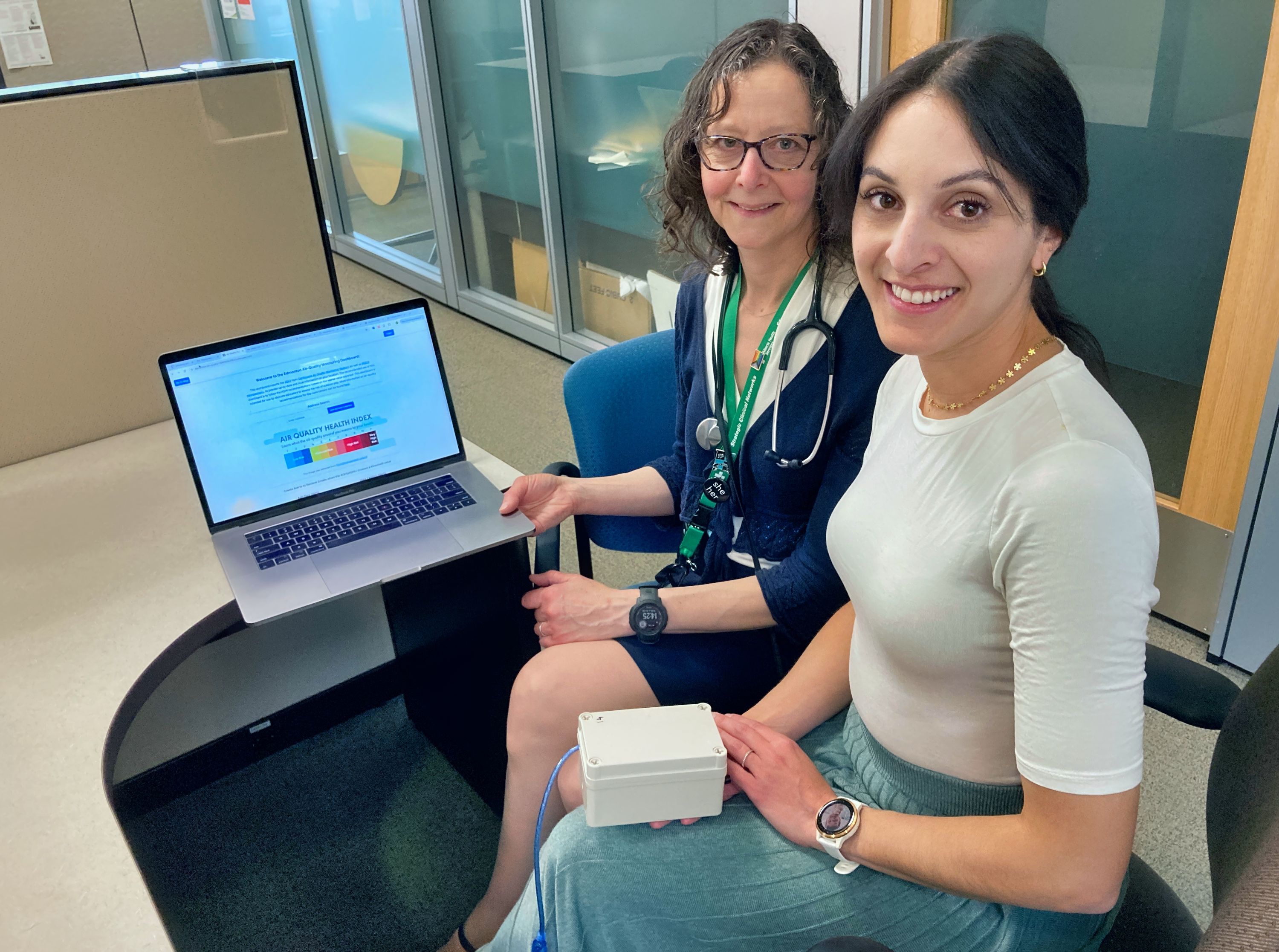Children in daycares could be breathing easier during wildfire season, thanks to a new University of Alberta research project.
A set of recommendations for outdoor and indoor air quality monitoring has been drawn up for Alberta’s child-care centres, through a collaboration between two experts in the Faculty of Engineering and the Faculty of Medicine & Dentistry.
“In the face of more intense wildfire seasons in Alberta, there are also more days with poor-quality air, so we really want to provide information that can empower child-care centres to promote the health of little ones in a way that is accessible and actionable,” says Amina Hussein, professor and Canada Research Chair in the Department of Electrical and Computer Engineering.
“Keeping your child’s lungs healthy means more healthy days and more days your child is in daycare learning and growing. Helping daycares and parents minimize the risk of exposure to unhealthy levels of chemicals in the air is preventive health at its best,” adds Department of Pediatrics professor Anne Hicks, clinical lead for the Children’s Environmental Health Clinic, and a member of the Alberta Respiratory Centre and Women and Children’s Health Research Institute.
The recommendations Hussein and Hicks compiled will help child-care centre staff assess the health risk to their tiny clients during events such as wildfires, when air quality is poor.
Babies and children are more vulnerable than adults to air pollution and wildfire smoke, notes Hicks, a pediatric respirologist.
“They tend to be more active than adults, and with their higher breathing rate and small body size, that means more exposure per body weight than an adult.”
Poor-quality air also affects their growth and development, she adds.
To form their recommendations, the researchers consulted with child-care centres such as the University Infant Toddler Centre and drew on a wide range of scientific data and studies about the health risks of air pollution. That includes risk from fine particulate matter, a major component of wildfire smoke.

Fine particulate matter is tiny enough to enter the lungs — and very fine particulate matter can enter the bloodstream — causing irritation of the eyes, nose and throat, mild cough, wheezing and headaches. At higher levels, the matter can cause more frequent and serious respiratory problems in children, such as asthma flare-ups and a higher risk that viral infections will lead to bronchiolitis.
Along with high-risk days, prolonged exposure — even to moderate levels of air pollution — can also pose serious health risks, notes Hicks, who was co-author of a study showing that more than 12,000 fewer people would die annually if the U.S. Environmental Protection Agency changed the cutoff for safe air quality to the level recommended by the American Thoracic Society, slightly more stringent than current standards.
The recommendations, which Hussein and Hicks will update as new scientific data is discovered, provide more information about air quality monitoring and the interpretation of the Government of Canada’s Air Quality Health Index (AQHI) for at-risk groups.
The AQHI considers three common air pollutants: fine particulate matter, nitrogen dioxide and ozone, using mortality data — how likely people are to die from poor air quality — to calculate risk.
“That outcome has the most validated data, but we should also be concerned about morbidity — negative health outcomes like hospital visits for breathing problems, and the long-term impacts of breathing air chemicals — for our children,” Hicks says.
Hicks adds that it would be helpful if the interpretation guide for the AQHI could provide recommendations about the potential long-term health risks of being outside at moderate to moderately severe levels of air pollution, especially for higher-risk groups like infants, young children and children with asthma or other lung diseases. She notes that more research may be needed to develop this information.
“It is important for children and families to take air pollution into consideration with their day-to-day activities.”
Along with that concern, local AQHI readings are reported based on three-hour rolling average measurements, Hussein notes. “That means there can be a lag that may not reflect the rapid changes in air quality that happen with wildfire smoke.”
Getting a better reading of air quality
The researchers’ recommendations lay out steps for assessing the risk of outdoor play, by obtaining local AQHI measurements immediately beforehand and throughout the day. But rather than relying solely on that data, child-care centres can also consider investing in air monitors, known as microsensors, outdoors in their own play areas, or use publicly available data from nearby sensors, as an additional source of information.
Microsensors are compact, relatively affordable devices that specifically detect small particulate matter in the air. Installed by various private and public users across Canada, including in Alberta, they provide localized readings of particulate matter. At the same time, AQHI continuous air monitoring stations across the province provide regional air quality data on all three of the major air pollutants.
“Using both methods together gives a more detailed assessment of nearby air pollution in real time, increasing the opportunity for child-care centres to make informed decisions about being outdoors,” Hussein notes.
To make that combined information easier for daycare staff to access, U of A software engineering students developed an award-winning, user-friendly dashboard.
The digital tool, which is still being refined before becoming publicly available, automatically reports both the AQHI values and microsensor readings on a single, accessible platform.
The dashboard is designed to pinpoint a daycare’s location and then share the values from the nearest AQHI station and the three closest microsensors, “so the daycare can do risk assessment for its chosen air quality cutoff,” says Hussein.
Users can also sign up to receive email alerts issued by the dashboard when either AQHI or microsensor readings exceed those chosen air quality thresholds.
The dashboard will make air quality monitoring much easier for daycare workers, says Hussein.
“Right now, looking at information from both the AQHI and a microsensor requires going to two different websites and zooming into your location on a map. That’s unwieldy to do while caring for a group of little ones.”
Clearing the air for kids
The recommendations include several policy suggestions for daycare centres, including expanding their emergency response plans to include wildfire smoke and extreme heat events.
Providing cool, clean environments for children could mean evacuating to a community centre or other public spaces with air conditioning if the daycare is adversely impacted by heat or smoke, the researchers advise.
“Extreme heat and poor air quality are emergencies. If a daycare’s system is overwhelmed and unable to provide sufficient air conditioning or air cleaning, for example in a power outage, there should be an evacuation plan, just like there would be for a fire,” Hicks says.
To keep air clean inside daycares, the recommendations also suggest considering the use of indoor air quality monitors, updating ventilation systems and, if necessary, using air cleaners with HEPA or equivalent filtration during wildfire smoke events.
“If it’s too hot or smoky outdoors, children need a safe space inside, so indoor air has to be healthy,” Hicks notes. Monitoring and improving the quality of indoor air is important beyond wildfire season, she adds, noting that everyday events like idling vehicles in dropoff zones can affect air quality inside buildings as well as outdoors.
Staff should also be prepared to spot signs of heat and smoke-related medical distress in children, know when to seek medical help and ensure youngsters with high-risk conditions like asthma have their medications at hand, the recommendations suggest.
“These measures give daycare providers the ability to intervene early and minimize the risk of more serious problems,” Hicks says.
The recommendations will be presented by Hussein and Hicks to child-care centres across the province during a public webinar on June 4, hosted by the Alberta Capital Airshed, which shares information about air quality in the region.
Hussein and Hicks plan to continue researching the use of microsensors with goals including understanding indoor air quality in daycares. “With things like vehicle idling and cooking, we want to find out which interventions actually improve it,” Hussein says.
As members of the U of A’s new Climate Change and Health Hub, they plan to tap into the knowledge of other experts for the project, she adds, noting how their own collaboration made it possible to create the recommendations and the dashboard.
“As crossover teams whose research questions are informed by affected communities, we can have this really powerful approach to address challenges associated with climate change and improve health.”
In-kind support for developing the recommendations was provided by the Alberta Capital Airshed, the Tomorrow Foundation and the University Infant Toddler Centre.
